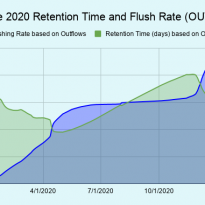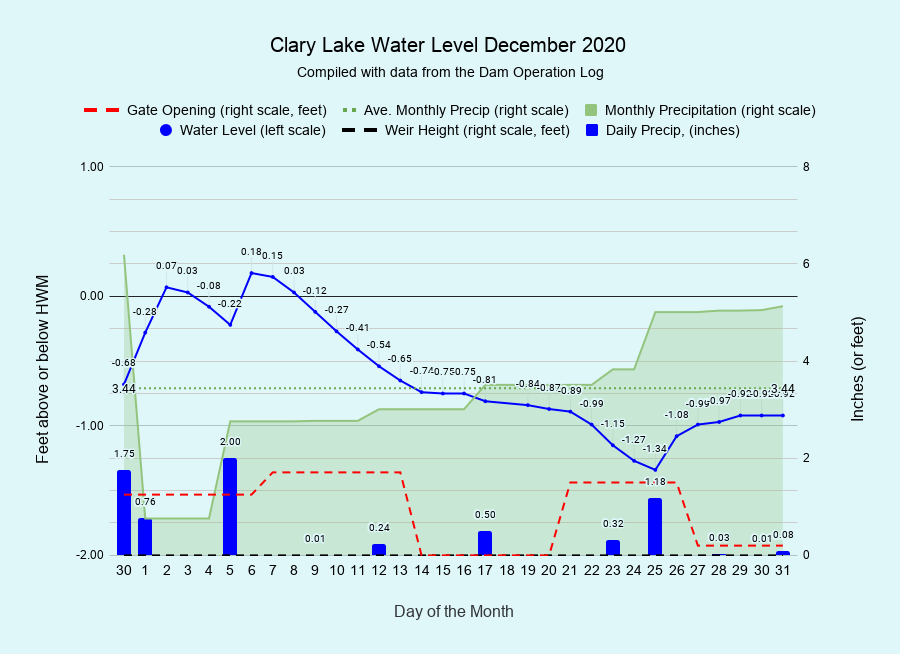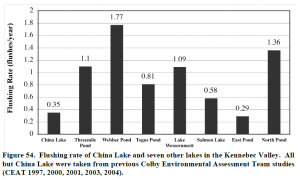And so we arrive at the end of another year. I have archived the December 2020 Water Level Chart (at left) and much like 2020 was a roller coaster year, December was a roller coaster month in terms of rainfall and resulting water level fluctuations! On the last day of November we received 1.75 inches of rain followed by 0.76 inches more the next day. This pushed the lake level from 0.68 feet below the HWM to 0.07 feet above the HWM almost overnight, resulting in water flowing over the top of the dam for the first time since last spring. Then on December 5th we received 2.00 inches of rain which drove the lake level even higher, to 0.18 feet above the HWM, despite our efforts to mitigate the lake level rise. From there the lake fell more or less steadily to the month low of 1.34 feet below the HWM. More rain on the 23rd and 25th of the month again pushed the lake level up to a little less than 1 foot below the HWM. It would have gone a lot higher if we hadn’t opened the gate to drain off more water in anticipation of the additional rainfall. The heavy rains, warm temperatures, and high winds on Christmas day resulted in most of the lake’s ice melting off. The lake completely froze over for the first time on December 19th. At the time of this writing, most of the lake remains ice free.
 The chart at left shows precipitation for the year. We received a total of 5.13 inches of rain in December, well above the average for the month of only 3.44 inches. The drought conditions that plagued us last last summer and which lasted through the fall finally abated with the rainfall we received in December. For the year we ended up with 45.33 inches, 1.27 inches more than the yearly average of 44.06 inches.
The chart at left shows precipitation for the year. We received a total of 5.13 inches of rain in December, well above the average for the month of only 3.44 inches. The drought conditions that plagued us last last summer and which lasted through the fall finally abated with the rainfall we received in December. For the year we ended up with 45.33 inches, 1.27 inches more than the yearly average of 44.06 inches.
 The chart at left shows the water level for the entire 2020 year. Included on the chart are both gate opening and weir height (in feet, right scale), and rainfall (in inches, also right scale). The water level (left scale) is given in feet above or below the high water mark, which is easier to interpret than elevations in feet above Mean Sea Level. The High Water Mark has an elevation of 151.17 feet, a level that is actually slightly higher than the top of the dam.
The chart at left shows the water level for the entire 2020 year. Included on the chart are both gate opening and weir height (in feet, right scale), and rainfall (in inches, also right scale). The water level (left scale) is given in feet above or below the high water mark, which is easier to interpret than elevations in feet above Mean Sea Level. The High Water Mark has an elevation of 151.17 feet, a level that is actually slightly higher than the top of the dam.
 The next chart I’m going to share is also one of my favorites, a composite chart that shows the water level for the years 2018, 2019, and 2020 superimposed on one chart. Unlike the 2020 water level chart which shows feet above or below the HWM, this one shows elevations in feet above Mean Sea Level. The chart includes dashed lines denoting the High Water Mark (elevation 151.17 feet), the top of dam (elevation 150.89 feet) and a dotted line showing the maximum draw down allowed under our Water Level Order (2 feet below the HWM or an elevation of 149.17 feet). Paul Kelley was in charge of operating the Clary Lake dam in 2018 until we bought the dam in mid-October. By the end of the year we had repaired the dam and restored the lake level.
The next chart I’m going to share is also one of my favorites, a composite chart that shows the water level for the years 2018, 2019, and 2020 superimposed on one chart. Unlike the 2020 water level chart which shows feet above or below the HWM, this one shows elevations in feet above Mean Sea Level. The chart includes dashed lines denoting the High Water Mark (elevation 151.17 feet), the top of dam (elevation 150.89 feet) and a dotted line showing the maximum draw down allowed under our Water Level Order (2 feet below the HWM or an elevation of 149.17 feet). Paul Kelley was in charge of operating the Clary Lake dam in 2018 until we bought the dam in mid-October. By the end of the year we had repaired the dam and restored the lake level.
The spreadsheet used to generate this composite chart is already pretty unwieldy, and chances are I won’t continue producing it. We’ll see.
 The last chart I’m going to share is one showing the Retention Time and Flushing Rate (based on outflows) for Clary Lake for the year 2020. The Flushing Rate is how many times over the course of the year that the entire volume of the lake is replaced. This can be calculated from inflows or outflows, and I’ve done it both ways, and the results are in close agreement. This chart uses outflows. Flushing rate is calculated from the sum of all the water leaving the lake (in acre-feet) divided by the lake volume (in acre-feet). The published flushing rate for Clary Lake is 1.81 times but as you can see from the chart, the measured flushing rate based on outflows from the lake is more like 2.3 times. How much water is that? Well the volume of Clary Lake is about 7224 acre-feet which is equal to 314,677,440 cubic feet of water. There are roughly 7.48 gallons per cubic foot so the lake volume in gallons is 314,677,440 x 7.48 = 2.353 billion gallons. Multiplying that number by 2.3 is about 5.4 billion gallons. That’s a lot of water!
The last chart I’m going to share is one showing the Retention Time and Flushing Rate (based on outflows) for Clary Lake for the year 2020. The Flushing Rate is how many times over the course of the year that the entire volume of the lake is replaced. This can be calculated from inflows or outflows, and I’ve done it both ways, and the results are in close agreement. This chart uses outflows. Flushing rate is calculated from the sum of all the water leaving the lake (in acre-feet) divided by the lake volume (in acre-feet). The published flushing rate for Clary Lake is 1.81 times but as you can see from the chart, the measured flushing rate based on outflows from the lake is more like 2.3 times. How much water is that? Well the volume of Clary Lake is about 7224 acre-feet which is equal to 314,677,440 cubic feet of water. There are roughly 7.48 gallons per cubic foot so the lake volume in gallons is 314,677,440 x 7.48 = 2.353 billion gallons. Multiplying that number by 2.3 is about 5.4 billion gallons. That’s a lot of water!
Clary’s high flushing rate is the result of it’s being a relatively small lake (763 acres±) in a relatively large watershed (9.9 square miles). Even Clary’s published flushing rate is higher than average. Flushing rates of other Maine lakes vary widely:
Retention Time is average length of time (in days) that water stays in the lake before finding it’s way to the outlet. It is by definition the inverse of the flushing rate. Going with the textbook definition, the inverse of 2.3 is 0.435 years or about 159 days. However, in actual practice, retention time can vary with varying inflows and outflows and since we measure and record both on a daily basis, we can calculate Retention Time daily by dividing the volume of the lake by the daily inflows (or outflows) in acre-feet. Taking the average of these daily values for the year yields a Retention Time of 144 days. There really isn’t much difference between 144 days and 159 days.
Understanding the flushing rate and retention time of a lake is crucial to understanding lake hydrology especially as it pertains to water quality and algae blooms and the movement of nutrients into and (out of) the lake. You’ll find Retention Time and Flushing Rate charts for both inflows and outflows in the 2020 Water Level Charts gallery, along with a few other charts that I haven’t mentioned. The data from which the above charts were created can be found in the 2020 Clary Dam Operation Log. I’ll be launching a new 2021 Clary Dam Operation Log tomorrow morning. Look for the link on the right sidebar of most pages or under the Charts/Data main menu heading.
As 2020 finally draws to a close, I’d like to take this opportunity to thank the members of our Dam Operations Committee for another year of exemplary service! From planning management activities to pulling or installing stop logs and opening and closing the gate, managing the dam is a huge responsibility and I couldn’t ask for a more dedicated, conscientious, and talented group of people to take it on. Thanks David Knight (our Chair and resident comedian), Steve Cowles, and Tim Chase!
Here’s looking forward to 2021,
George Fergusson



Awesome collection of information, George. I doubt if very many lake associations have data this sophisticated to aid in water level management.
There’s a fair amount of water quality information available for most Maine lakes, but not a whole lot of hydrologic data- flows, areas, volumes, flushing and retention rates, etc. From a purely practical point of view, how important is it really? It’s certainly interesting and that’s enough justification for me 🙂
George, Thank you for doing this. As you say, it is very interesting to look at. Well done, thanks again. Jack
Interesting is all well and good, but my goal real is education!